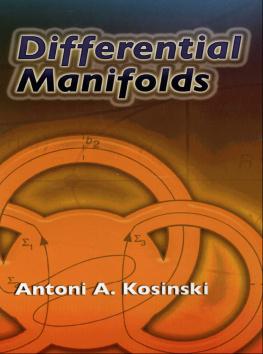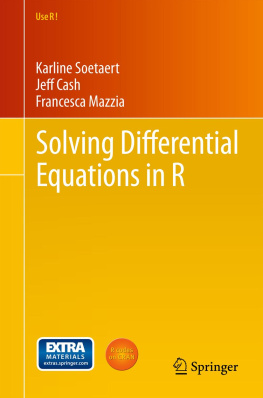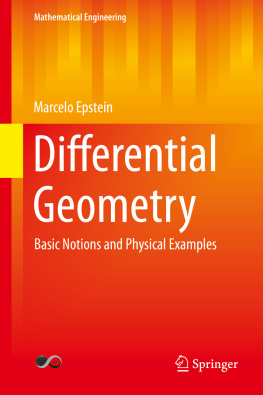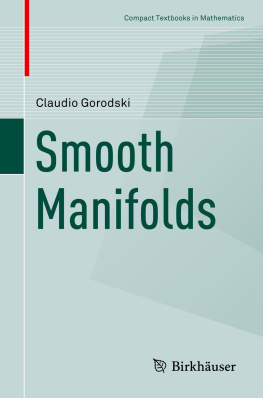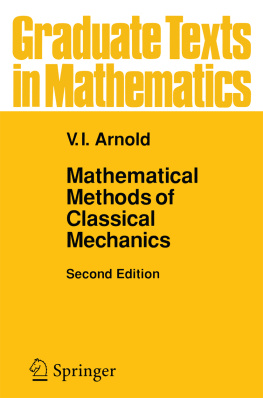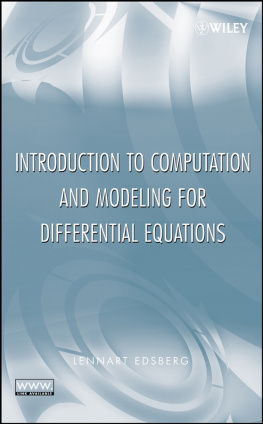Differential
Manifolds
With a New Appendix by John W. Morgan
on the Work of Grigori Perelman
Antoni A. Kosinski
Department of Mathematics
Rutgers University
New Brunswick, New Jersey
Dover Publications, Inc.
Mineola, New York
Copyright
Copyright 1993 by Antoni A. Kosinski
All rights reserved.
Bibliographical Note
This Dover edition, first published in 2007, is an unabridged, slightly corrected republication of the edition originally published by Academic Press, Boston, in 1993. The present edition includes a new Appendix by John Morgan on the work of Grigory Perelman (see ).
Library of Congress Cataloging-in-Publication Data
Kosinski, Antoni A,, 1930
Differential manifolds I Antoni A. Kosinski.
p. cm.
This Dover edition, first published in 2007, is an unabridged, slightly corrected republication of the work originally published by Academic Press, Boston, in 1993.
ISBN- 13: 978-0-486-46244-8
ISBN-10: 0-486-46244-7
1. Differential manifolds. I. Title.
QA614.3K66 2007
516.36dc22
2007018107
Manufactured in the United States of America
Dover Publications, Inc., 31 East 2nd Street, Mineola, N.Y. 11501
This book is dedicated to the memory of my father,
the founder and publisher of Mathesis,
the first scientific publishing house in Poland.

April 1963 Symposium in honor of Marston Morse,
Institute for Advanced Study, Princeton, New Jersey.
First row, seated, from left: S. S. Chern, R. J. Pohrer, A. Selberg,
M. Morse, W. Leighton, M. Hirsch, S. S. Cairns, H. Whitney.
Second row, standing, from left: R. Bott, B. Mazur, G. A. Hedlund, T. Frankel,
S. Smale, N. Kuiper, J. F. Adams, W. Browder, J. W. Milnor, M. Kervaire.
Contents
Introduction
Three decades ago differential topology went through a period of extremely rapid growth. Six years after Milnors discovery of non-equivalent smooth structures on a topological sphere such structures were already classified through the newly invented method of surgery. In the same period Smale showed that every manifold can be constructed by successive attachment of handles and provided a method to obtain the most economical description. This enabled him to prove the Poincar conjecture in higher dimensions, thereby demonstrating the strength of his methods. Also in the same period, Smale, Haefliger, and Hirsch developed the theory of imbeddings and immersions, vastly extending the foundational results of Whitney.
The methods invented in these early years subsequently gave rise to a large amount of research. Thus the handle constructions of Smale were extended by Kirby and Siebenmann to topological manifolds, and the method of surgery was expanded and applied successfully to a large variety of problems by Browder, Novikov, and Wall.
Looking back at these developments it appears possible at present to single out certain main ideas and results and present them in a systematic and consolidated way. This is what I have attempted to do here. In a very broad way, the content of this book can be described as the study of the topological structure of smooth manifolds. As I intended this book to be accessible at the beginning of graduate studies, this is preceded by a presentation of basic concepts and tools of differential topology.
An overview of the material follows. More precise information is in the introductions to the individual chapters.
The first two chapters introduce in moderate detail the notions of smooth manifold, submanifold, and tangent space. Imbeddings are discussed briefly and isotopies at length. The presentation is complete, but it is assumed, implicitly, that the subject is not totally unfamiliar to the reader. A more leisurely treatment of the analytical topics of these two chapters can be found in [].
In it is shown that a neighborhood of a submanifold of a smooth manifold can be fibered by planes, that is, it is a vector bundle, and that this bundle structure is unique. This is a fundamental result and the basis for all that follows.
The concept of transversality due to Thom is introduced in . This is the smooth counterpart of the notion of general position and is used similarly to extract from messy entanglements their essential geometric content. In this chapter it is applied to prove that every function can be approximated by one with a very regular behavior at singularities, a Morse function. It is also used to define intersection numbers. This geometric concept will in later chapters supplant the less intuitive cup product.
The results of are not utilized elsewhere in this book. It provides an introduction to the beautiful and difficult theory of foliations.
These first four, or five, chapters constitute a general background not only for differential topology but also for the study of Lie groups and Riemannian manifolds. The analytical means employed here have their roots in the implicit function theorem, the theory of ordinary differential equations, and the Brown-Sard Theorem. Some algebraic results in the form adapted for the purpose and collected in the appendix are used as well. Very little algebraic topology enters the picture at this stage.
that all highly connected manifolds can be constructed in this way.
describes the situation when two successive attachments of handles produce no change: The second handle destroys the first. This is Smales Cancellation Lemma.
begins with the proof that every manifold can be built by a successive attachment of handles of increasing dimension. To such a structure there is associated a chain complex yielding the homology of the manifold. The chains are linear combinations of handles and the boundary operator is given by a matrix of intersection numbers. Of course, the same is true for a triangulation or a cellular decomposition, but the relation between the handle presentation and the homology structure of the manifold is very transparent geometrically. This fact is exploited here to obtain a simple proof of the Poincar duality theorem and of the Morse inequalities providing the lower limit for the number of handles necessary to construct a manifold with given homology. The 3-dimensional case, at the end of the chapter, provides a nice illustration of basic ideas.
contains the proof of the existence of a handle presentation with the minimal number of handles determined by its homology groups. The following example should explain the importance of this idea. The minimal number of handles necessary to build an n-dimensional sphere is two: two n-discs glued along boundaries. If we succeed in proving that a homotopy sphere admits a presentation with the minimal number of handles determined by its homology, then it must admit a presentation with two handles. In turn, this implies that it is homeomorphic to the sphere, i.e., the Poincar conjecture.
The proof we give here follows the original idea of Smale to manipulate handles, not the Morse functions, and adopts the following point of view. The homology of the manifold is given by chain groups (generated by handles) and homomorphisms described by matrices of intersection numbers. It is well-known how this structure can be reduced through a sequence of algebraic operations to the most economical form, for instance, with all matrices diagonal, etc. We try to find geometric operations on handles that are reflected by these algebraic operations on their algebraic counterparts: the generators of chain groups. The key to success is in the cancellation lemma, which, together with Whitneys method of eliminating unnecessary intersections, permits the actual geometric elimination of those handles whose presence is algebraically superfluous.
Next page
